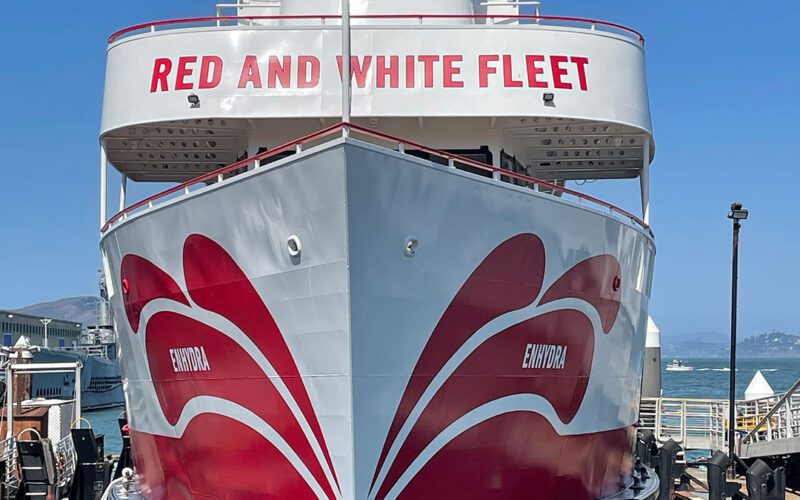
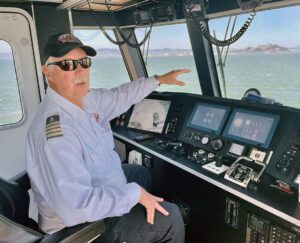
Capt. Mike Minard steered Enhydra toward the west side of Alcatraz Island and eased back on the throttles. Right on cue, the hybrid propulsion system switched from diesel engines to battery power.
It’s hard to say if the passengers noticed as they snapped photos of “The Rock” off the starboard side. Engine noise went from a low rumble to a barely audible hum as the vessel glided across the water.
“You can hear how quiet it is,” said Minard, a 10-year captain with the historic Red and White Fleet tour company. “Even when the gensets are running…the vessel is still really quiet.”
There are many benefits to a hybrid propulsion system, from lower emissions and fuel consumption to reduced maintenance costs and less frequent engine overhauls. But for the fabled Red and White Fleet, the quieter platform for its paying customers was an important consideration, too.
“It’s a new vessel, which everybody likes,” said Joe Burgard, managing director and partner at San Francisco-based Red and White Fleet. “But the passengers really seem to like the fact that it is so quiet and it really is a beautiful boat. The crew like it, the guests like it and it’s working as it was designed.”
Enhydra was the first hybrid tour boat operating in the United States when it entered service in 2018. The 128-foot aluminum monohull was constructed in Bellingham, Wash., by All American Marine using plans developed by its longtime partners at Teknicraft Design.
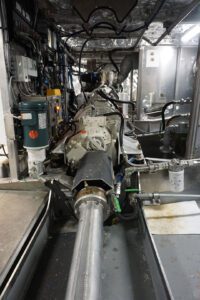
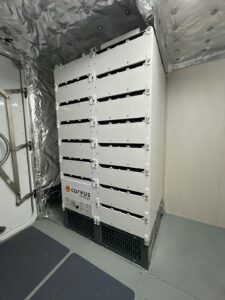
The tour boat’s BAE Systems HybriDrive propulsion system is notable in part for what it lacks. Instead of main engines, the vessel is driven by twin 410-hp Cummins QSL9 diesel generator sets that turn the 48-inch propellers on each side.
During periods of lower power demands, or when idling at the dock, Enhydra can automatically revert to batteries to supply hotel loads or propulsion through 300-kW traction motors that turn the shafts. Two
80-kW lithium-ion battery banks stored in an air-conditioned rooms can be charged via shore power or from the Cummins gensets.
The maritime press bestowed numerous accolades on Enhydra after it entered service. That includes Professional Mariner, which named it “Ship of the Year” in late 2018. Red and White still highlights those honors at its primary operation at San Francisco’s Pier 43 ½, located on the bustling Fisherman’s Wharf waterfront.
Being the first to try new technology can bring its share of challenges. Conventionally vessels driven by diesel engines are a known commodity for maritime crews, operators, and the third-party technicians that help keep them running. One of the biggest challenges for operating Enhydra was the relative scarcity of built-in local knowledge of hybrid propulsion systems.
“When we first got the vessel it’s not as if there were ten people who have worked on the system in the Bay Area. Instead, it might be there was someone on the East Coast who you would fly out,” he said. “It hasn’t been harder than a conventional vessel, it is just different.
“One thing that is unique about the boat is that we have so much insight into each component and access to diagnostics that are better than anything I am aware of in a conventional application,” Burgard continued. “That makes it easy to drill down on anything anomalous that is going on.”
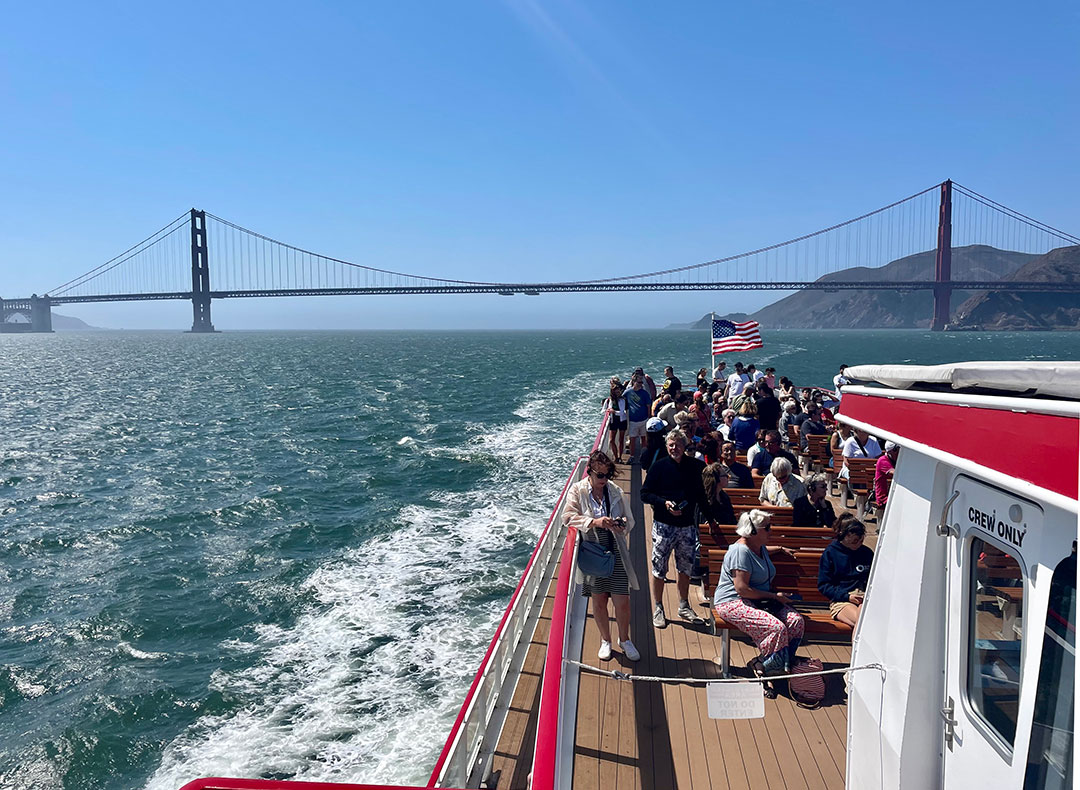
Back on Enhydra, nearly 200 passengers were aboard for a recent weekday tour around San Francisco Bay. Most found a spot on the exposed upper deck to soak up the sunshine and the world-class views. The 600-passenger vessel operated with five crewmembers consisting of Minard, three deck hands, and a bartender.
“OK, we are ready to go,” Minard said as he stepped onto the starboard wing station and backed the vessel away from the Pier 43 ½, spinning the vessel counterclockwise, heading for the open waters of the central Bay.
The highlights of the tour generally stay the same, the route can vary based on what’s happening along its route. Yachting events can force the ship further from shore, while tricky tidal activity can determine how far Enhydra will travel beyond the Golden Gate Bridge. Another trick for Red and White captains is to make sure the vessel doesn’t outrun the narration, which guides passengers toward landmarks on land and water.
Enhydra is Red and White’s sole aluminum vessel in a fleet of steel hulls. It’s lighter than those older vessels, and it draws less water − characteristics that took some time for captains to get used to.
“It is super, super light so it can be blown around a lot,” Minard said. “But the design is sound, and it handles really, really nice.”
The breeze was just picking up as Enhydra sailed to the west along the north side of San Francisco. The vessel passed the Marina District and other landmarks, including the Palace of Fine Arts and Crissy Field, a sandy beach where many a wind or kite surfer launch their craft.
Those thrill-seekers are among the primary challenges for captains, who also must keep an eye on recreational and commercial traffic running through the Bay. Wind and kite surfers will sometimes cross the tour boat’s bow, pass over its wake, or cruise alongside the tour boats depending on the conditions.
“And they fall,” Minard said. “They can be falling left and right, and they can fall right in front of you. You really have to watch out for them.”
Fog is another chronic presence in San Francisco. Locals refer to it as ‘Karl,’ and its arrival can be a sight to behold. Minard likened it to a waterfall as the clouds travel east through the Golden Gate and down the mountains behind Sausalito.
Enhydra sailed at about 12 knots under power from its Cummins generators as it approached the Golden Gate Bridge and the Marin Headlands − the rugged hills on the north side of the span. The vessel passed directly under the massive 8,900-foot bridge and proceeded for another half-mile toward Point Diablo Light before topping around and returning to the Bay.
The narration highlighted Angel Island and Sausalito as the vessel took a more northerly route toward Alcatraz Island, another highlight of the tour. Minard reduced power, which automatically triggered the switch to battery power, to give passengers as much time as possible alongside the island.
The tour boat’s BAE HybriDrive propulsion system has multiple modes the operator can select, including an all-electric setting. Hybrid mode automatically cycles the generators on- or off-based power demands as Minard demonstrated while maneuvering around Alcatraz. Other settings keep the generators on in standby mode or prepare the vessel to charge the batteries from shore power.
“We typically run in hybrid mode where the vessel is all-electric during low loads and the generators automatically come on based on load demands,” Burgard said, likening the system to that of a hybrid vehicle.
Long-term data on fuel savings and emissions has been hard to calculate in any meaningful way, in part because of long-term disruptions during the COVID-19 pandemic. But Burgard said maintenance costs are effectively cut in half due to engine run hours compared to a similarly sized conventional vessel powered by two diesel main engines.
Much has changed with hybrid and electric propulsion since Enhydra entered service. New California vessel emission regulations will soon require tour operators to install hybrid powerplants on new vessels.
Meanwhile, advances in battery technology are giving operators more options for all-electric voyages. Federal, state and local funding has also emerged to help offset the costs of installing shore power and other critical charging infrastructure.
The Red and White Fleet, which was founded in the late 1800s, developed Enhydra so it could run for an entire day on electric power. That is still the plan, Burgard said. But for now, the vessel’s hybrid powerplant actually exceeds California’s regulatory rules.

With the tour winding down, Minard steered around Alcatraz Island and pointed the bow toward the San Francisco-Oakland Bay Bridge before turning back toward its Fisherman’s Wharf berth. The final leg of the tour offers passengers a clear view of the city’s downtown skyline and other features along the eastern Embarcadero waterfront.
The early afternoon voyage was the second tour of the day for Minard, who joined the Red and White Fleet after working as captain of a scuba diving boat. He typically leads up to six tours a day and the subtle variations of each voyage and the challenges of running a boat in San Francisco Bay keep him on his toes.
“I’ve got to say, I feel really lucky. I get to come out here I get to see these great views, and it changes every day,” he said. “I get to see the wildlife, the whales and the harbor porpoises and all the boat traffic that I really enjoy.
“Everyone who gets on this boat is predisposed to be happy, and hopefully when they leave they are even happier. I tell the crew, we’re making people happy and lining our pockets,” he said. “What could be better?” •

